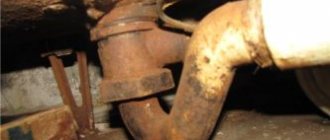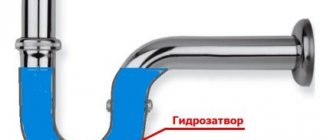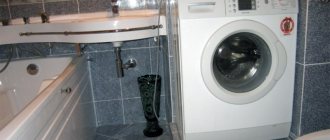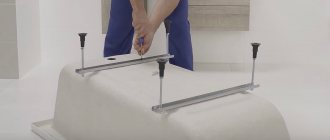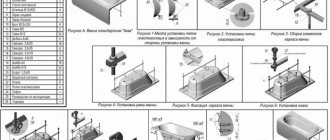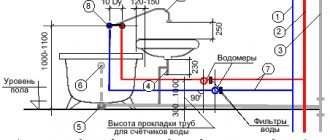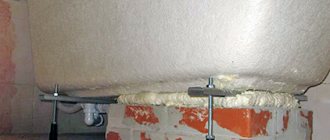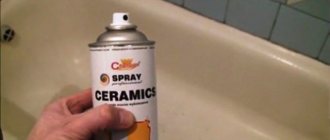Basic device
What do you need to start from to understand what kind of device this is? Everyone has known since Soviet times a siphon with a rubber stopper on a metal chain. This is what the basic model of the drain-overflow design looks like. Progress in the production of sanitary ware does not stand still. Today, even this design has undergone changes.
To drain the water, you no longer need to bend over and pull out the plug. The bathroom drain has become automated. There are a variety of device types available for sale. The drain-overflow system is often sold together with the bathtub. Masters advise choosing it yourself.
Types of material
When choosing an overflow drain, attention must be paid to the material itself. It must be resistant to corrosion. In this case, preference should be given to:
- Plastic for sanitary fixtures, which is called polypropylene. This material has a white color, a laconic shape and a fairly long service life. However, there is a risk of breakage.
- Black metal. It is one of the most reliable materials. But its disadvantage can be considered the appearance of the device, which looks a little rough.
- Copper, brass and bronze. All of these metals are coated with a protective layer and each of them is characterized by long service life. The big advantage is that you can choose an interesting color that will harmonize perfectly with the rest of the bathroom design. And due to its resistance to harmful corrosive effects, all parts are quite easily and simply connected using the existing thread.
As for the last option, you should be careful during installation. Even a small scratch can cause subsequent destruction of the entire surface layer.
Description of the drain-overflow mechanism
The function of the device is to drain liquid from the font into the sewer pipe. The entire system consists of interconnected hoses and tubes that are connected to two holes in the bowl and a sewer. The hole at the top on the wall of the bath prevents liquid from overflowing, the hole at the bottom is for draining liquid.
If the structure is installed correctly, then overfilling the tank is basically impossible. You can arrange it later if the speed at which the bowl fills with water is greater than it comes out.
Installing a drain siphon
Of course, you should also study all the features of the installation process. In the kit for the drain and overflow, the manufacturer usually provides small installation instructions, and if everything is done according to it, you will be able to install the device. But problems may arise in the process. The installation principle for semi-automatic and conventional devices is almost the same. Everything is done in several stages.
- If we are talking about replacing an old siphon with a new model, then you should dismantle the device and carefully clean the fastening elements (so that nothing interferes with the elements performing their functions).
- It is necessary to take the bottom overflow, install a rubber gasket in it and attach it to the drain hole. At the same time, with your free hand you need to place the upper element on the hole, insert the screw and tighten it. But it’s worth considering that you don’t need to screw it in too tightly, because the body of the part is quite fragile.
- The upper part, the overflow, is installed in the same way. It is better to install the pipe, which is designed to drain excess liquid, not vertically, but slightly to the side, this will make it more convenient to install.
- At the next stage, the drain and overflow must be connected to each other; a corrugated hose is used for this purpose. But in no case should you cut it to shorten the element; you can bend it a little. First you need to put the nut on the corrugation and only then install the gasket.
- A water seal is attached to the drain pipe under the bathtub bowl. Here you should take into account such a nuance that before connecting the elements you need to carefully inspect the fasteners and find out if there is any damage or other problems. All burrs and casting defects must be cut off to ensure high-quality sealing.
- After this, you need to attach the pipe to the water seal. This is necessary in order to connect the device to the sewer. Everything is done in the same way as connecting the pipe and the valve.
- Connecting the siphon to the sewer. Here it is necessary to take into account that in some variants of drains and overflows the connection is made directly into the socket of plastic structures, in other variants a sealing collar is used.
- After that, all that remains is to check the build quality. This is very simple to do, you just need to open the tap and fill the bath bowl with water. If there are no leaks when the drain is closed, then everything is installed correctly.
Classification of types of drain mechanism
Three types of devices are considered and each has its own design features.
Standard type device
This simplest design is represented by components:
- a siphon is represented by a pipe. It stops the penetration of unpleasant odors into the room;
- drain hole for overflow;
- liquid outlet hole at the bottom of the bowl;
- connecting tube for siphon and sewer pipe;
- The liquid is poured through a corrugated pipe into the siphon.
The mechanism is called traditional. When the drain neck is closed with a stopper, water is drawn into the tank.
Operational problems may arise with rubber gaskets. They change periodically. The price of a standard mechanism is 10-25 dollars.
It is classified as a reliable mechanism, since there are no moving elements in its design. The simple drain design is easy to assemble and install yourself.
Differences between automatic and semi-automatic mechanisms
Structurally, the drainage mechanism for the bathtub is designed in two types:
- automatic bath drain;
- semi-automatic in the bathroom.
Automatic bath drain
The device is also called “click-click”. The system works very simply. At the bottom of the bowl there is a button that starts the automatic siphon. The first press of the button opens the drain, the second press closes it. The operation of the mechanism depends on the spring that is attached to the system plug.
Features of work
The peculiarity of the work is that it is a simple process. One of the sides of the bath has been overflowed and re-released. The gap from the side to the overflow is usually 5 centimeters. On the reverse side of the overflow, a receiving block is fixed to its opening, and the grille is attached from the outside.
The block is connected from the lower outlet to the pipe using a drain pipe. The siphon body can be disassembled, but current prototypes are made with a monolithic glass. The system works using simple technology. When it is necessary to fill the bathtub with water, the bottom drain must be closed with a stopper. In case the height of the water coincides with the overflow hole, the water is drained through the drain tube into the outlet, then into the sewer. If you have a well-functioning overflow, there is no chance of water overflowing over the edges of the bathtub.
The first company to produce an automatic decanter is considered to be a company from Germany. In general, the overflow receiver and drain pipe are no different from traditional piping.
The innovation consists of the use of a special plug device, which is equipped with a specific spring and, in addition, a lock. Thanks to this, you just need to press the button and, if necessary, either shut off the drain or open it. It is very easy to use, as the button can be easily pressed even with your foot.
Also, the binding is determined from a sophisticated point of view. However, it is necessary to acquire only high-quality automatic drains, since a complex design of poor quality can lead to repeated breakdowns. This harness cannot be repaired and will have to be replaced with a new one.
The semi-automatic bathtub connection features are similar to automatic ones. In this system, the following components control the operation: a receiver with a control unit, a cable and a plug. The control unit is a plug (handle or valve). In all control options, the overflow hole is hidden under the block. Under the influence of pressure on the controlled block with the help of a cable, the force is transmitted to the plug itself.
Operating such a system is quite simple and it provides the ability to control the stopper from inside the bath itself and from the outside. The convenience lies in the fact that there is no need to immerse your hands in water, since, for example, the water may be drawn too cold or too hot.
Whether you choose automatic or semi-automatic tying depends primarily on your selectivity, need and financial resources.
Installation of bath trim
Installation of the system begins only after the position of the bath is fixed. It is set according to level and height. This is especially true for products made of acrylic and metal, since they are unstable due to their light construction.
It is not recommended to completely cover the bathtub structure with facing material without an inspection hatch. It will provide quick access to the drain system in an emergency.
There are general recommendations for installing an automatic and semi-automatic bath overflow drain system:
- After installation, a distance of 15 cm is maintained between the base of the siphon and the floor covering.
- The tee hole is connected to the grille at the drain hole.
- A rubber gasket is installed at the time of connection.
- The siphon is connected to the outlet from the tee using a nut.
- The pipe is fixed on the side at the branch of the tee.
- The siphon is connected to the sewer.
- Each part of the device is sealed.
The work completed is checked. To do this, the tank is filled with water. A dry cloth is spread on the floor so that drops of water are visible if the system is not installed properly. A hole opens and the liquid flows down the drain system.
Operating principle of a bath siphon: semi-automatic
Let's look at what a semi-automatic water drain system is and also answer the question of how it works.
Bath siphon: semi-automatic
The main feature of a semi-automatic siphon is the presence of a thin connecting cable between the mechanisms of the upper part of the drain and overflow system with its lower drain part.
You can open or close the drain siphon with a slight movement of your hand by turning the overflow cover (top of the system).
Among the advantages we can safely highlight:
- Ease of use.
- Aesthetically beautiful appearance of the product (in this case there is no open top part, like old drain systems, which simply looks like a hole covered with a plastic grill).
The disadvantages include the fact that in cheap models, as well as in recast models (copies of models of well-known brands), after a certain time from the start of using the drain system, the connecting cable may begin to jam, which will undoubtedly affect the quality of operation of the entire drain systems.
The siphon can be either brass or copper, depending on the chosen drain system model.
Manufacturers rating
- The automatic model of the Kaiser brand, produced in Germany, has won a leading position in the Russian market. The price of the structure is up to 3.0 thousand rubles.
- For buyers with average incomes, systems from the Viega and Geberit brands are offered. In terms of build quality, Geberit is inferior to Viega.
- Semi-automatic drain-overflow systems from the Abelone brand are in demand on the plumbing market. The automatic mechanism of this company can withstand 50 thousand operating cycles (the mechanism opens and closes). It is made of copper, various coatings are applied. Machine price: 3.2 – 3.5 thousand rubles.
- If you don’t want to spend money on bathtub drainage systems, then Frap brand models are ideal. The company produces budget and luxury devices. Their price: 1.0 – 3.0 thousand rubles.
- Easy to install Equation brand models. The company produces a system for both bathtubs and washbasins. Most models are made of plastic.
